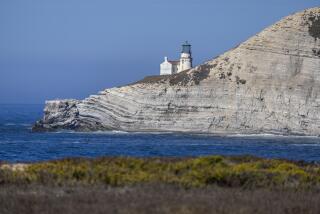Floating Center Offers Lifeline to Alaska Wildlife
- Share via
KODIAK ISLAND, Alaska — A dozen endangered sea lions gather around two divers waving strange contraptions far below the ocean surface off the coast of Kodiak Island.
Brian Fadely, a federal wildlife biologist, grips a noose attached to a 50-foot line, while his colleague Kate Call wiggles a herring at the end of a short pole to coax one of the hefty pups through the hoop.
Another curious Steller sea lion is caught for science.
Five researchers in a skiff are ready to crate the startled 200-pound animal for the short ride to the research vessel Tiglax, the only ship of its kind among the 540 national wildlife refuges in the country.
Once it’s aboard the ship, scientists with the National Marine Fisheries Service anesthetize the 5-month-old pup, glue a satellite transmitter to its back, then release it back into the frigid sea to be tracked over the next several months.
By the end of the 17-day excursion from Kodiak to the eastern Aleutian Islands in November, researchers had tagged 13 young sea lions, believed to be the most vulnerable age group of an endangered species off Alaska’s coast. The ongoing juvenile tracking effort has intensified over the last few years, but there’s always one constant -- the Tiglax.
“It’s a very comfortable ship to be on,” said Fadely, a repeat passenger on various fisheries service projects. “It’s set up for research, it’s got good food and an outstanding crew.”
In service for 16 years, the Tiglax has emerged as a major player in managing the Alaska Maritime National Wildlife Refuge, which extends from the state’s southeastern arm to the Aleutian Islands to the Arctic Slope. It’s a floating science center with access to many of the 2,500 islands, islets and headlands that make up the 3.5-million-acre refuge.
Researchers from federal agencies, universities and other institutions use the 120-foot vessel for hundreds of projects, keeping track of the health and welfare of the Far North’s abundant marine life. Most of the research is done along the Aleutians and Gulf of Alaska during the warmer months, when lush grasses sprout waist-high and the region comes alive with millions of returning seabirds, whales, otters and sea lions.
“If we didn’t have this vessel, we wouldn’t have a biological research program anywhere near the depth we presently have,” said refuge manager Greg Siekaniec.
The Tiglax (pronounced TEKH-lah) -- an Aleut word for eagle -- is outfitted with wet and dry laboratories, as well as sampling nets, depth sounders and other equipment. The vessel also transports researchers and supplies to some of the most remote destinations on Earth.
The notorious storms that regularly pummel the gulf region can be a challenge to the six-man crew. But the steel-hull vessel has proven its seaworthiness, withstanding waves that shoot as high as the wheelhouse. In the recent sea lion trek, the crew managed to skirt a series of storms, dodging 100-mph winds in the protected bay of an island in the eastern Aleutians.
“The experience that crew has with the waters we work in is just invaluable,” Fadely said. “They’re great at reading the weather and its interaction with currents and tides, which allows us to maximize our working opportunities.”
Before the Tiglax, scientists were limited to chartered excursions after an aging smaller vessel was retired in the late 1970s. In 1987, the U.S. Fish and Wildlife Service, which oversees the refuge, commissioned the 16-passenger ship, launching a new era in field research.
“It’s expanded our ability for research big time,” Siekaniec said.
Refuge biologist Steve Ebbert leads Tiglax-dependent projects, including one to eradicate arctic foxes introduced to dozens of Alaska islands for a long-departed fur industry. The animals are a threat to indigenous birds, such as rock ptarmigan.
In the last five decades, foxes have been eliminated from 40 islands but remain on several more, Ebbert said. Next spring, the Tiglax will take a team to one of the populated sites to set lethal traps. Another effort aims to rebuild rock ptarmigan populations on the Near Islands at the western end of the Aleutians. Foxes had wiped out the birds on all but one of those islands, Attu, until the Tiglax was pressed into service.
In 1999, the refuge began moving a breeding population of ptarmigan from Attu to Agattu Island, 30 miles to the south. Last summer, more than two dozen birds made the 3 1/2-hour journey inside the Tiglax’s wet laboratory.
“It’s the coolest, quietest part of the ship,” Ebbert said. “Ptarmigan are susceptible to heat, so they did great in there.”
Perhaps the ship’s most notable success has been restoration of the Aleutian Canada goose, a species unseen in the Aleutians between 1938 and 1962, when biologists found 200-300 birds on a remote island on the western end of the chain.
Recovery efforts began in the mid-1960s, and the Tiglax played a critical role, ferrying large numbers of the white-banded geese from Buldir Island to ones that were free of predators.
The goose was removed from the endangered species list in 2001, and now there are more than 37,000 in the Aleutian Islands.
“The Tiglax definitely enhanced the project because it was available whenever we needed it,” said Vernon Byrd, supervisory refuge biologist. “It was there to do the job.”
More to Read
Sign up for Essential California
The most important California stories and recommendations in your inbox every morning.
You may occasionally receive promotional content from the Los Angeles Times.













